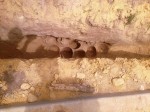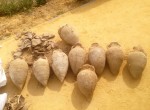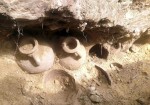 On Wednesday, April 27th, workers digging a trench in Olivar del Zaudín Park in Tomares, a suburb of Seville, Spain, discovered a cache of clay jars nestled three feet under the surface. They alerted the Civil Guard who found there were 19 Roman-era amphorae crammed full of bronze coins from the late 3rd and early 4th century A.D. The number of coins has yet to be determined, but the total weight of them is a staggering 600 kilos (1,300 pounds).
On Wednesday, April 27th, workers digging a trench in Olivar del Zaudín Park in Tomares, a suburb of Seville, Spain, discovered a cache of clay jars nestled three feet under the surface. They alerted the Civil Guard who found there were 19 Roman-era amphorae crammed full of bronze coins from the late 3rd and early 4th century A.D. The number of coins has yet to be determined, but the total weight of them is a staggering 600 kilos (1,300 pounds).
 The amphorae and coins were transported to the Archaeological Museum of Seville where conservators have begun to clean, stabilize, identify and count them. Museum director Ana Navarro is not yet able to estimate the total number of coins in the collection. There are tens of thousands of them, that much is clear from the weight. Initial examination has found the coins were minted during the reigns of the emperors Maximian (r. 286-305) and Constantine (r. 306-337) and appear to be in brilliant uncirculated condition, with no signs of wear whatsoever. They are made of bronze but some of them show signs of having been silvered, ie, coated with a thin layer of silver totalling maybe four or five percent of the coin weight.
The amphorae and coins were transported to the Archaeological Museum of Seville where conservators have begun to clean, stabilize, identify and count them. Museum director Ana Navarro is not yet able to estimate the total number of coins in the collection. There are tens of thousands of them, that much is clear from the weight. Initial examination has found the coins were minted during the reigns of the emperors Maximian (r. 286-305) and Constantine (r. 306-337) and appear to be in brilliant uncirculated condition, with no signs of wear whatsoever. They are made of bronze but some of them show signs of having been silvered, ie, coated with a thin layer of silver totalling maybe four or five percent of the coin weight.
 The amphorae are special too. Out of the 19 amphorae, nine of them were perfectly intact with their coins untouched inside. The other ten were damaged by the excavator at the time of discovery (a cloud with a silver lining because it gives archaeologists the opportunity to see how the coins were packed in the vessels). They are not of the kind used to transport the wine, fermented fish intestine sauce and grains that Romans were so fond of. They’re smaller than standard merchant amphorae and may have been designed specifically to carry cash. The amphorae were placed vertically in packed earth up to their shoulders and then covered by bricks and pieces of broken ceramic. It’s not clear if they were deliberately hidden underground due to social unrest, violence or danger, or if this was a deposit space inside a fort or military structure of some kind.
The amphorae are special too. Out of the 19 amphorae, nine of them were perfectly intact with their coins untouched inside. The other ten were damaged by the excavator at the time of discovery (a cloud with a silver lining because it gives archaeologists the opportunity to see how the coins were packed in the vessels). They are not of the kind used to transport the wine, fermented fish intestine sauce and grains that Romans were so fond of. They’re smaller than standard merchant amphorae and may have been designed specifically to carry cash. The amphorae were placed vertically in packed earth up to their shoulders and then covered by bricks and pieces of broken ceramic. It’s not clear if they were deliberately hidden underground due to social unrest, violence or danger, or if this was a deposit space inside a fort or military structure of some kind.
 The find is unique in Spain and likely the rest of the Roman world. Navarro and her team contacted researchers in Britain, France and Italy and they all agreed that they have never seen so large and homogeneous an accumulation of coins from the late Roman empire. Because of their homogeneity, tight date range and amphorae, the coins were not a private treasure. Navarro speculates that they could have been pay for the army or civil servants, or perhaps destined for the imperial tax coffers. Less than a tenth of the coins have been examined at this point, so it’s too early to draw any conclusions.
The find is unique in Spain and likely the rest of the Roman world. Navarro and her team contacted researchers in Britain, France and Italy and they all agreed that they have never seen so large and homogeneous an accumulation of coins from the late Roman empire. Because of their homogeneity, tight date range and amphorae, the coins were not a private treasure. Navarro speculates that they could have been pay for the army or civil servants, or perhaps destined for the imperial tax coffers. Less than a tenth of the coins have been examined at this point, so it’s too early to draw any conclusions.
 The region in which they where they were found was a powerful economic center in the Roman Spain province. The ancient city of Italica, founded in 206 B.C. by Publius Cornelius Scipio, future victor over Hannibal in the Second Punic War, is just next door. Emperors Trajan and Hadrian were born there. It’s a good thing the coins weren’t kept in the big city, however, as after its decline the nearby city of Seville, Hispalis in Roman times, used Italica as a quarry. As late as the 18th century Seville was still feasting on the bones of its ancient neighbor. Seville demolished the walls of Italica’s amphitheater in 1740 and used the stone to build a dam and demolished the old Republican city in 1796 to build a road with its stone. It wasn’t protected until 1810 under Napoleon.
The region in which they where they were found was a powerful economic center in the Roman Spain province. The ancient city of Italica, founded in 206 B.C. by Publius Cornelius Scipio, future victor over Hannibal in the Second Punic War, is just next door. Emperors Trajan and Hadrian were born there. It’s a good thing the coins weren’t kept in the big city, however, as after its decline the nearby city of Seville, Hispalis in Roman times, used Italica as a quarry. As late as the 18th century Seville was still feasting on the bones of its ancient neighbor. Seville demolished the walls of Italica’s amphitheater in 1740 and used the stone to build a dam and demolished the old Republican city in 1796 to build a road with its stone. It wasn’t protected until 1810 under Napoleon.
 The Olivar del Zaudín Park’s land was two farmsteads in the Middle Ages, nothing worth messing with when there was a far more obvious ancient target drawing focus. They were eventually combined and made into an olive orchard. Olive trees still dot the landscape today. Just a few miles west of Seville, the 45-hectare site has never been developed and, thanks to its extensive flora and natural lagoon system with four lakes, is an ecological preserve for a plethora of nesting and migratory birds, insects, butterflies, reptiles, fish and amphibians.
The Olivar del Zaudín Park’s land was two farmsteads in the Middle Ages, nothing worth messing with when there was a far more obvious ancient target drawing focus. They were eventually combined and made into an olive orchard. Olive trees still dot the landscape today. Just a few miles west of Seville, the 45-hectare site has never been developed and, thanks to its extensive flora and natural lagoon system with four lakes, is an ecological preserve for a plethora of nesting and migratory birds, insects, butterflies, reptiles, fish and amphibians.
 The same fortunate happenstance that over the millennia preserved the site for nature also preserved 19 amphorae of coins. The crew was working on a canal project as part of a regeneration plan to restore the lagoons, sustain the olive trees and eventually build a bird observatory, work which has now been suspended as a consequence of the momentous find. An emergency excavation will take place before work resumes.
The same fortunate happenstance that over the millennia preserved the site for nature also preserved 19 amphorae of coins. The crew was working on a canal project as part of a regeneration plan to restore the lagoons, sustain the olive trees and eventually build a bird observatory, work which has now been suspended as a consequence of the momentous find. An emergency excavation will take place before work resumes.
[youtube=https://youtu.be/vtZmOKOCZCw&w=430]
Heh.. A handful of coins is a interesting find. This? Too much of a good thing! They probably will NOT remove the coins from the unbroken jars.
🙂 Gotta’ love Coin Hoards. I have no doubt they will want to know what is there before work resumes even if different ground penetrating radar types, metal detectors and a few test pits are what tells them.
I sometimes think that it should be possible just to guess where Roman traces could be found. In my teens I had a conversation with my father about why we didn’t have some sort of Roman fort or camp within a mile or two of our house. We agreed that there were two likely locations. (i) To control the best river crossing, it would be where the Norman castle later stood. That was obviously a no-hoper: nobody was going to dig into a large Norman mound in vague hopes that there might have been Romans there first. Or (ii) it could be on the the local hill, a good defensive spot that would allow the soldiers to keep an eye on traffic up and down the firth, and along the plain. A few years later such a camp was found in location (ii).
I suppose that I really should have tried to persuade my schoolmates that we should have looked for the traces ourselves, though God knows what damage a bunch of enthusiastic but ignorant laddies might have caused.
it’s no surprise there was crazy rampant inflation during late antiquity. there’s a lot of roman coins floating around out there. just check out eBay. the rampant inflation was one of the reasons that led to the breakdown of the empire, and causes large estates to become self efficient.
@dearieme – In some cases it is possible to just guess where Roman traces could be found.
Follow their roads or ‘limites‘ – and sometimes also the rivers involved.
Seems a shame it required action by a French Emperor to protect what was left of the birthplace of two Roman ones…still, for anyone with any interest in the period, and who might be traveling in that part of the former Roman world, make time to visit Italica and the Archaeological Museum in Seville – you will not be disappointed.